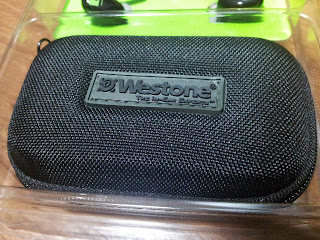 |
| Got them from Stereo Electronics at Ion Orchard |
 |
| Front of box |
 |
| Peeping in at the left phone |
 |
| Read face of box |
 |
| Side of box |
 |
| Box opened up |
 |
| Left page of box interior |
 |
| Contents of box |
 |
| Semi-hard case |
 |
| Ear buds supplied |
 |
| Ear buds and cleaning brush |
 |
| Altogether again |
A few days after I went there, I was at the Stereo Electronics at Ion Orchard looking for the UM1 again. The sales guy gave me some good recommendations on similar products in the same performance/price range. Some of them were from Etymotic, Westones UM1 and Westone 1.
I found Etymotic to be a bit too soft and (I never thought I would say this) ... flat and smooth. This is the exact feature I was looking for .. flat frequency response. However, I found Etymotic phones to be just that, in an unpleasant way. Areas of high frequency that were supposed to be crisp were somewhat muted in intensity, and overall I had to turn up the volume higher than my normal levels (I am not a loudness fan), just to hear my test tracks properly.
I took a listen to UM1, which sounded more lively but I could hear a roll off on the highs and some muffled lows.
In the end I decided to go with the Westone1. Somehow the stereo image is better an does give nice response across the frequency, for me.
The way the phones are shaped to the ear is quite comfortable, with the connecting cables looping behind the user's ear. This minimises microphonics. I came across this term when doing my research on in-ear-monitors in general. I'll write more about this below.
 |
| Image taken from a review on the Westone1: http://www.headfoneshop.com/blog/2011/07/28/westone-1-review/ |
The cables are formed by smaller cables coiling around each other in a braid. This keeps the cable straight and minimises the chance of the tangling, especially useful for musicians planning to use them for gigs and on-stage performances.
The thing I find a bit of an inconvenience in the first few days of usage is the fact that there were no easily legible markings on the body of the earphones as to which is the left or right piece. This was partially caused by the fact that I took a while to familiarise with the unique way the cables have to coil around the ear lobes. However, true to what the sales staff told me, "you'll get used to it after the first week". Now I just instinctively know which piece goes left and which one to the right.
I think I have rather large ear canals, I find that I cannot easily get a proper seal with the default ones that were already attached to the phones when I opened the box. As seen in the photos above, Westone has supplied quite a few kinds of ear-tips, so I will be going through them to find the suitable size and shape for me. I'll write a bit more about seal below.
Overall I am quite happy with this pair of in-ear-monitors. It is my first set that has a balanced armature. Now I am hearing lots of detail in my mp3 recordings. I am spotting new things in recordings I thought I was quite familiar with. Most importantly, I am using the Westone1 to listen to my own compositions so I can evaluate my own mix that's done through my speakers, to find out how they sound on a very accurate pair of in-ear-monitors.
The topics covered in here also include the ones I will write about below: microphonics and seal.
Microphonics is the interfering (undesirable) vibrations (turned into audible sounds in the earphones), caused by the moving/rustling of cable contacting with our skin, clothings, or other items in the path of the cables. This is especially likely for people listening to music while exercising (eg, jogging). Here is a pretty good article to read up on microphonics affecting the clarity of our earphones - http://ear-buds.org/microphonics-and-how-it-affects-your-earbuds/
The seal is another term I learnt when reading up about in-ear monitors. Seal is something provided by the earbuds. It is how completely the earbuds fit the shape of your ear and isolates surrounding noise when you use your earphones. This is very important to users of in-ear monitors. The sound-isolation factor and the perceived power and clarity of the phones is totally dependent on the seal. If there is no seal (earbuds not successfully forming an enclosed space inside the ear), then there is sound leakage. This will affect the overall sound in general, but mostly the noise isolation and the power of the bass will suffer. That is why there are many 3rd party providers of earbuds. Having different shapes and sizes to suit a huge variety of ears, some are made from memory foam, some are sponge, some are silicone and others, rubber.
Because our ears come in very different shapes and sizes, no two buds will give the same results on different individuals. Similarly, to get a good seal, there is no 'best position' for the bud to rest in the ear canal. We must use it for a while (people say a week of use) to let it find its unique rest position the ears for best seal.
Sensaphonics provide users with test tones at equal levels so the user can decide if both sides of earbuds are providing similar levels of seal. This is a pretty neat test! http://www.sensaphonics.com/?page_id=833



No comments:
Post a Comment